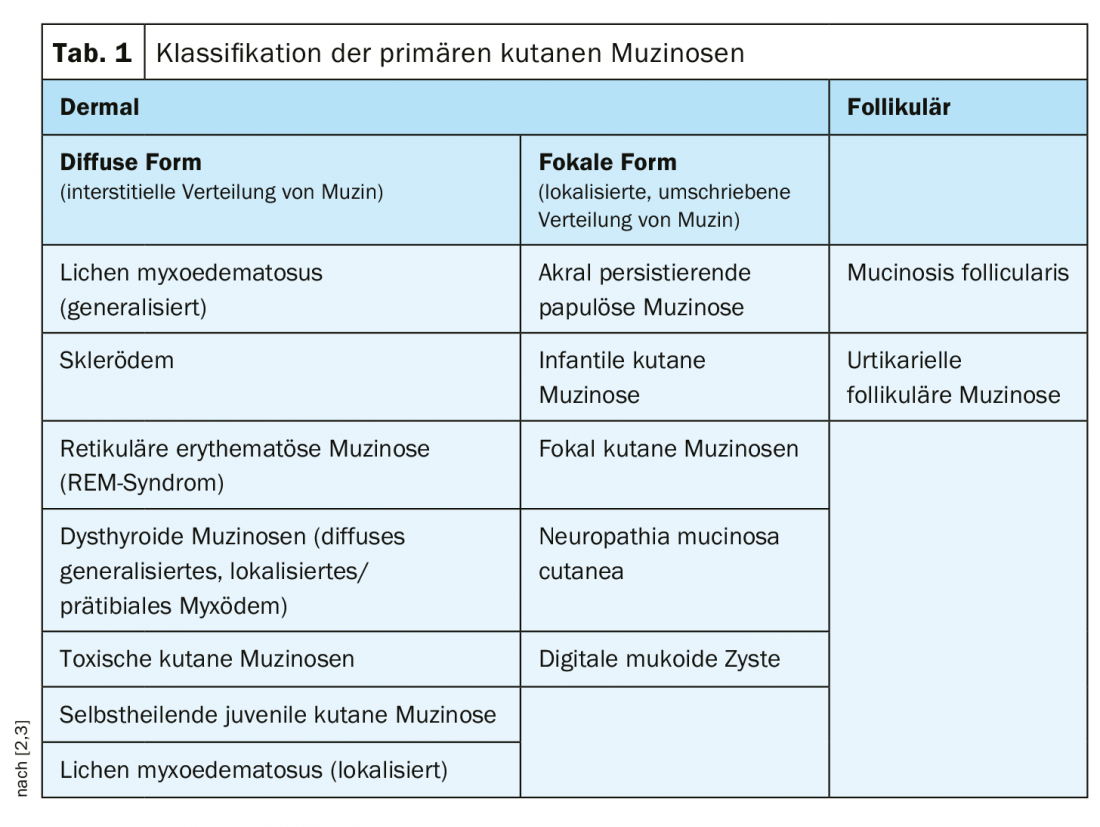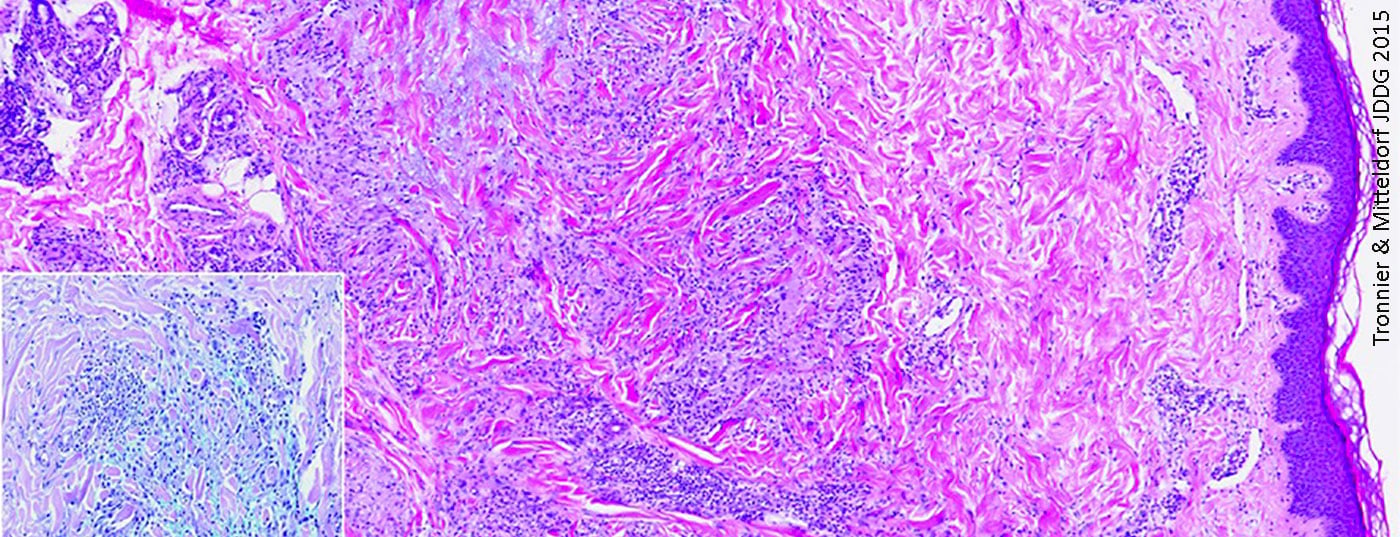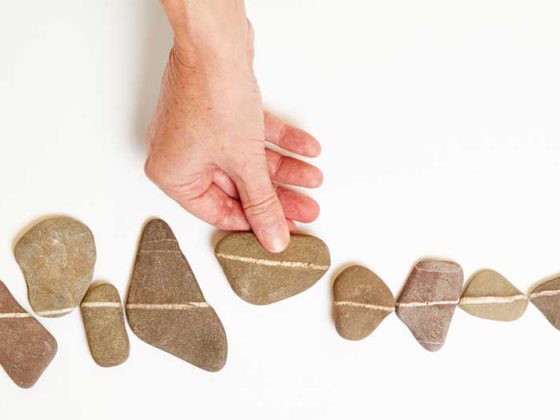Mucin deposits are possible in all skin layers, and the site of deposition is not pathognomonic. In addition to primary mucinosis, this deposition dermatosis often manifests as an epiphenomenon. The etiopathogenesis is not fully understood.
At this year’s ZDFT, Prof. Reinhard Dummer, MD, Chief Physician at the Department of Dermatology, University Hospital Zurich, and team (Thierry Nordmann, MD, Carole Guillet, MD) gave a lecture on mucinoses [1] as part of the main topic of deposition dermatoses. The deposited mucin is a substance consisting of a mixture of glycosaminoglycans also found in healthy skin in free form (hyaluronic acid) or bound form (proteoglycans). Glycosaminoglycans are water-binding elements of connective tissue that play an important role in the consistency and turgor of the skin and are produced by fibroblasts or keratinocytes. Pathogenetically, there is either increased synthesis or impaired degradation of glycosaminoglycans.

Differential Challenge
Primary cutaneous mucinoses are divided into dermal and follicular subtypes; dermal subtypes are subdivided into a diffuse form (interstitial distribution of mucin) and a focal form (localized circumscribed distribution of mucin) (Table 1) [2,3]. Primary mucinosis is rather rare, more frequent is the occurrence of this deposition dermatosis in the context of inflammatory and proliferative processes (reactive phenomenon). In lupus erythematosus and also in the granulomatous dermatosis granuloma anulare (DD necrobiosis lipoidica), an increased occurrence of mucin is a differential diagnostic criterion. However, mucin proliferation can also occur in many other inflammatory processes. Furthermore, in the tumor stroma of mesenchymal and adnexal tumors, connective tissue may be mucin-rich. An assignment of dermal mucinosis as a symptom of various primary diseases is summarized in Table 2.

REM syndrome: controversy over etiopathogenesis.
Reticular erythematous mucinosis, also known as REM syndrome, was first described in 1974 [1,3]. The etiopathogenesis of REM syndrome has not been fully elucidated to date; among other things, it is discussed whether it could be a clinical variant of cutaneous lupus erythematosus [3]. Typical clinical features are streaky reticular, urticarial, slightly infiltrated, reddened plaques in the upper central part of the trunk, with a majority of young women affected [3]. Sunlight exposure can lead to aggravation of symptoms [1]. In terms of clinical manifestation, there is overlap between REM syndrome and lupus erythematosus tumidus (progressive form of cutaneous lupus erythematosus) and lymphocytic infiltration of the Jessner and Kanof type. To date, it is unclear to what extent these diseases represent distinct entities [3]. Fibroblasts from REM patients show a norm deviant response to stimulation with exogenous IL-1β, which plays a role in the possibly dysregulated hyaluronic acid metabolism in REM syndrome [1]. The differential diagnostic distinguishing features between REM syndrome and lupus tumidus are summarized in Table 3.

Lichen myxoedematosus: consider exclusion diagnoses
Lichen myxoedematosus is a rare primary mucinosis with a chronic progressive course [3]. Two subtypes are distinguished: the localized form and the generalized form (Table 4) [1]. The latter is also known as scleromyxedema and is characterized by sclerodermiform, papular features.
Predilection sites of localized lichen myxoedematosus are the backs of the hands, extensor sides of the arms, upper trunk, face, and axillae [3]. Typical features are single skin-colored, reddish papules that may confluence and appear as lichenification and/or general thickening of the skin. Mucin distribution in the context of the localized form may be diffuse or focal. There is controversy in the literature as to whether discrete lichen myxoedematosus, acral persistent papular mucinosis, self-healing papular mucinosis (juvenile/adult form), infantile mucinosis, and nodular form should be considered distinct subtypes of localized lichen myxoedematosus. Classic symptoms of the generalized subtype (scleromyxedema) are generalized erythematous thickening of the skin, which can lead to mimic rigidity and restricted joint movement; in some cases, cardiovascular abnormalities have been observed in addition to myopathies and neurologic symptoms [3]. The differential diagnosis of scleromyxedema must be differentiated clinically and histologically from other papular changes such as systemic scleroderma and scleredema. A distinguishing feature from other mucinoses are characteristic histologic findings in local lichen myxoedematosus and scleromyxedema. These are characterized, among other things, by marked mucin deposition in the middle and upper dermis and often an increase in fibroblasts with large, stellate nuclei; in addition, collagenous fibers may be compacted and increased (fibromucinosis), and there may be a small perivascular lymphocytic infiltrate [3]. Topical glucocorticoids and topical calcineurin inhibitors are recommended as therapy for lichen myxoedematosus; PUVA and laser treatments may also be used. In some cases, symptom reduction could be achieved with cytostatics (cyclophosphamide, chlorambucil, melphalan), isotretinoin, and plasmapheresis, and occasionally with intravenous immunoglobulins as well as high-dose melphalan and autologous peripheral blood stem cell transplantation [3]. The speaker pointed out that in the presence of localized lichen myxedematosus, malignancy and thyroid disease are important diagnoses for exclusion [1].

Follicular mucinosis: prominent follicular ostiae
Unlike REM syndrome and lichen myxoedematosus which are dermal subtypes, follicular mucinosis is histologically characterized by mucin deposition in the follicles. In addition, there is an atypical lymphocytic infiltrate, as well as degeneration of the epithelium [1]. Clinically, the follicular subtype manifests as focal, follicular, skin-colored to erythematously elevated papules and plaques with prominent follicular ostia (sometimes with comedone-like keratotic patches). Etiopathogenetically, initial lymphocytic inflammation is discussed as a possible cause of secondary mucin accumulation. There is thought to be a continuous transition from mucinosis follicularis (more common in young patients) to folliculotropic mycosis fungoides (more common in older patients) [1].
Mucin deposition in the context of multisystemic diseases.
Granuloma anulare (Fig. 1) is a noninfectious granulomatous disease of unclear etiology [6] that occurs frequently in younger patients [7]. Predilection sites of the symptoms, which usually manifest in the form of anular or arciform plaques, are mainly the extremities [7]. Deposition of mucin in the area of connective tissue degeneration is an important histological feature [8]. This is well recognized histopathologically in Alcian blue or colloidal iron stains [8]. In most cases, the epidermis is not affected; in the dermis, degenerated connective tissue surrounded by slightly elongated palisade-like arranged epithelioid cells is present [8]. In addition to a solitary form, there is also a disseminated form, which can occur, for example, in the context of a diabetic disease, whereby this primarily affects cases in older age [7].

Lupus erythematosus is an inflammatory autoimmune disease with heterogeneous clinical manifestations and courses [9]. Systemic lupus erythematosus is a potentially life-threatening multisystem disease with cutaneous involvement. The occurrence of skin lesions during the course of this disease is common and may occur in up to 70-85% of patients [9]. In acute cutaneous lupus erythematosus, a localized form (butterfly erythema) is distinguished from a generalized variant (maculopapular exanthema), being the most common subtype of systemic lupus erythematosus (30-60%) [9]. Histopathologically, a cell-poor interface dermatitis and a rather sparse perivascular lymphocytic infiltrate with mucin deposits are typical findings of acute cutaneous lupus erythematosus [9].
Dermatomyositis is another primary disease with dermal mucin deposits as a typical histopathological feature [10]. These occur in the context of inflammatory lesions in the dermal-epidermal transition layer [10].
Source: ZDFT, Zurich
Literature:
- Dummer R, Guillet C, Nordmann Th: Slide presentation: annual theme – depositional dermatoses. Mucinoses. Prof. Dr. med. Reinhard Dummer & Team, 9th Dermatological Training Days 2019, Zurich, June 26, 2019.
- Rongioletti F, Rebora A: Cutaneous mucinoses: microscopic criteria for diagnosis. Am J Dermatopathol 2001; 23: 257-267.
- Kuhn A: Mucinoses. Brown-Falco’s Dermatology, Venereology and Allergology 2017; 1-9.
https://link.springer.com/referenceworkentry/10.1007%2F978-3-662-49546-9_93-1) - Schallera J, Meigelb WN: Depositional dermatoses, in: Histopathology of the Skin ed: Cerroni L et al, 2nd edition 2016, Springer: Berlin Heidelberg. DOI 10.1007/978-3-662-44367-5_24-1, https://link.springer.com/content/pdf/10.1007%2F978-3-662-44367-5_24-1.pdf
- Rongioletti F, et al: Reticular erythematous mucinosis: a review of patients’ characteristics associated conditions, therapy and outcome in 25 cases. Br J Dermatol 2013; 169: 1207-1211.
- Piette EW, Rosenbach M: Granuloma annulare. Pathogenesis, disease associations and triggers, and therapeutic options. JAAD 2016; 75 (3): 467-479. www.jaad.org/article/S0190-9622(15)01500-5/abstract
- Houriet C, et al: Skin manifestations in internal diseases – 1st part, University Department of Dermatology, Inselspital Bern. Schweiz Med Forum 2013;13(47): 949-953, https://boris.unibe.ch/45902/1/houriet_smf_1.pdf
- Tronnier M, Mitteldorf C: Histologic features of granulomatous skin diseases: Part 1: noninfectious granulomatous diseases. Minireview. JDDG 2015; 13 (3): 211-216, https://onlinelibrary.wiley.com/doi/full/10.1111/ddg.12610_suppl
- Sticherling M, Kuhn A: Lupus erythematosus. Brown-Falco’s Dermatology, Venereology, and Allergology 2017; 1-18, https://link.springer.com/referenceworkentry/10.1007%2F978-3-662-49546-9_54-1
- Miller ML: Diagnosis and differential diagnosis of dermatomyositis and polymyositis in adults. UpToDate, www.uptodate.com/contents/diagnosis-and-differential-diagnosis-of-dermatomyositis-and-polymyositis-in-adults
DERMATOLOGIE PRAXIS 2019; 29(5): 41-43 (published 10/10/19, ahead of print).











